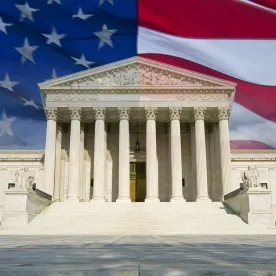During October Term 2018 (“OT2018”), the Supreme Court reversed less than two out of every three cases – its lowest reversal rate in three years. The Sixth Circuit fared particularly well (4 affirmances, 3 reversals), joining the Eleventh and D.C. Circuits as the only circuits to post a winning record. Notably, the Court did not affirm or reverse the Sixth Circuit along partisan lines. The two most frequent votes for reversal, for example, were Justices Sotomayor and Gorsuch.
OT2018 was the Learned Sixth’s first term with more affirmances than reversals since SCOTUSBlog first published a “Circuit Scorecard” after OT2004. Over the previous fourteen terms, the Sixth Circuit had gone 16-68. Of course, reversal rates do not necessarily mean much. As Justice Jackson once said, “We are not final because we are infallible, but we are infallible only because we are final.”
The seven cases from the Sixth Circuit included two Social Security cases, two Armed Career Criminal Act (ACCA) cases, and a novel Twenty-First Amendment case. We’ll start with some of the good news—two of the Circuit’s four wins.
Quarles v. United States — In its prior decision in Taylor v. United States, 495 U.S. 575 (1990), the Supreme Court held that, for purposes of the Armed Career Criminal Act, the generic term “burglary” means “unlawful or unprivileged entry into, or remaining in, a building or structure, with intent to commit a crime.” Quarles addressed the narrow question whether “remaining-in” burglary “(i) occurs only if a person has the intent to commit a crime at the exact moment when he or she first unlawfully remains in a building or structure, or (ii) more broadly, occurs when a person forms the intent to commit a crime at any time while unlawfully remaining in a building or structure.”
In an opinion by Judge Siler (joined by Judges Moore and Griffin), the Sixth Circuit concluded that the generic term “burglary” does not require an intent to commit a crime at the time of entry. Michigan’s third-degree home invasion statute—which merely required commission of a crime “at any time” the defendant unlawfully remained in a dwelling—therefore constitutes a “burglary” for ACCA purposes.
Writing for a unanimous Court, Judge Kavanaugh affirmed the Sixth Circuit’s opinion, holding that “remaining-in” burglary occurs when the defendant forms the intent to commit a crime at any time while unlawfully remaining in a building or structure.
Biestek v. Berryhill — In Biestek, the Court addressed what constitutes “substantial evidence” in a benefits hearing under the Social Security Act. During the hearing, the SSA relied on the testimony of a vocational expert, who based her opinion regarding the availability of job opportunities for the claimant primarily on private market-survey data. The question was whether the expert’s refusal to provide that data to the claimant precluded her testimony from constituting “substantial evidence.”
Writing for a unanimous panel, Judge Cook (joined by Judges Clay and White) ruled that testimony based on a vocational expert’s “professional experience” can constitute substantial evidence, so long as the testimony is not “conjured out of whole cloth.” Judge Cook emphasized that the ALJ considered the claimant’s objections and assessed the credibility of the witnesses at the hearing – determinations to which a reviewing court typically defers.
In an opinion by Justice Kagan, the Supreme Court affirmed, rejecting any categorical rule that an expert’s refusal to supply underlying data during an SSA hearing prevents the expert’s opinion from constituting substantial evidence. Justice Sotomayor and Justice Gorsuch (joined by Justice Ginsburg) dissented, arguing that the expert’s conclusory testimony did not constitute substantial evidence.





 />i
/>i

